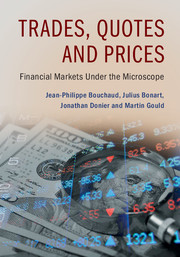Book contents
- Frontmatter
- Dedication
- Contents
- Preface
- Acknowledgements
- PART I HOW AND WHY DO PRICES MOVE?
- PART II LIMIT ORDER BOOKS: INTRODUCTION
- PART III LIMIT ORDER BOOKS: MODELS
- PART IV CLUSTERING AND CORRELATIONS
- PART V PRICE IMPACT
- 11 The Impact of Market Orders
- 12 The Impact of Metaorders
- PART VI MARKET DYNAMICS AT THE MICRO-SCALE
- PART VII ADVERSE SELECTION AND LIQUIDITY PROVISION
- PART VIII MARKET DYNAMICS AT THE MESO-SCALE
- PART IX PRACTICAL CONSEQUENCES
- Appendix
- Index
- References
12 - The Impact of Metaorders
from PART V - PRICE IMPACT
Published online by Cambridge University Press: 26 February 2018
- Frontmatter
- Dedication
- Contents
- Preface
- Acknowledgements
- PART I HOW AND WHY DO PRICES MOVE?
- PART II LIMIT ORDER BOOKS: INTRODUCTION
- PART III LIMIT ORDER BOOKS: MODELS
- PART IV CLUSTERING AND CORRELATIONS
- PART V PRICE IMPACT
- 11 The Impact of Market Orders
- 12 The Impact of Metaorders
- PART VI MARKET DYNAMICS AT THE MICRO-SCALE
- PART VII ADVERSE SELECTION AND LIQUIDITY PROVISION
- PART VIII MARKET DYNAMICS AT THE MESO-SCALE
- PART IX PRACTICAL CONSEQUENCES
- Appendix
- Index
- References
Summary
It doesn't matter how beautiful your theory is, it doesn't matter how smart you are. If it doesn't agree with experiment, it's wrong.
(Richard P. Feynman)In the previous chapter, we considered how the arrival of a single market order impacts the mid-price. However, as we noted in Section 10.5.1, most traders do not execute large trades via single market orders, but instead split up their trades into many small pieces. These pieces are executed incrementally, using market orders, limit orders, or both, over a period of several minutes to several days. As we saw in the last chapter, the chaining of market orders greatly affects their impact. Therefore, understanding the impact of a single market order is only the first step towards understanding the impact of trading more generally. To develop a more thorough understanding, we must also consider the impact of metaorders (defined in Section 10.4.3).
The empirical determination of metaorder impact is an important experiment whose results, when measured properly, are of great interest to academics, investors and market regulators alike. From a fundamental point of view, how does a metaorder of size Q contribute to price formation? From the point of view of investors, what is the true cost of performing such a trade? How does it depend on market conditions, execution strategies, time horizons, and so on? From the point of view of regulators, can large metaorders destabilise markets? Is marked-to-market accounting wise when, as emphasised above, the market price is (at best) only meaningful for infinitesimal volumes?
Naively, it might seem intuitive that the impact of a metaorder should scale linearly in its total size Q. Indeed, as we will discuss in this chapter, many simple models of price impact predict precisely a linear behaviour. Perhaps surprisingly, empirical analysis reveals that in real markets, this scaling is not linear, but rather is approximately square-root. Throughout this chapter, we present this square-root law of impact and discuss several of its important consequences.
Metaorders and Child Orders
Assume that a trader decides to buy or sell some quantity Q of a given asset. Ideally, the trader would like to buy or sell this whole quantity immediately, at the market price.
- Type
- Chapter
- Information
- Trades, Quotes and PricesFinancial Markets Under the Microscope, pp. 229 - 244Publisher: Cambridge University PressPrint publication year: 2018

